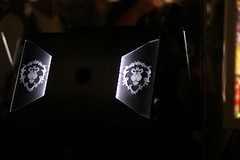 Amazon has just launched their Kindle e-book reader. Sporting a display of 6 inches with 167 ppi of electronic paper (e-paper) resolution, and weighting just 10.3 ounces (about the size of a small paperback book), it features both Wi-Fi and has a built-in EVDO modem.
Amazon has just launched their Kindle e-book reader. Sporting a display of 6 inches with 167 ppi of electronic paper (e-paper) resolution, and weighting just 10.3 ounces (about the size of a small paperback book), it features both Wi-Fi and has a built-in EVDO modem.
The EVDO modem utilizes the cellphone network so that hunting for a Wi-Fi hotspot isn't necessary, making books available to purchase anytime you can get reception from the Sprint network. Despite the fact that it uses Sprint, there's no fees and no contract for using the wireless network. Can you surf the web on it? Yes. Can you e-mail from it? Yes, for 10 cents per e-mail.
The design of the device feels a mite unfriendly (and ugly) to me, with the buttons for next and last page mounted on large buttons on the sides of the device, I feel that you're essentially holding the Kindle at the bottom of the device, rather than the middle, which I believe may be problematic. The keyboard is a good idea, but I feel the keyboard should have been hidden in a sliding design, as the only time you need it is a small percentage to the main function of the device, to read books.
Keeping in mind that this device is released by Amazon, their motivation for releasing this device is pretty clear: they want to sell you reading material. Despite the free wireless service, putting anything on this device has a cost associated with it. Unless otherwise marked, all New York Times bestsellers and new releases are 9.99 or less, and magazines and newspaper subscriptions are reasonably priced and are priced on a monthly basis such as the New York Times for 13.99 a month, and TIME for 1.49 a month. Since the new media publisher is the internet, high volume blogs like Boing Boing are also available on Kindle for 1.99 a month. While I read Boing Boing daily, much of their content is based on providing links to other sources, and I'm curious if being part of Amazon's subscription is going to change their style of writing up articles. Content being offered for Kindle of course, provides another alternate revenue stream for bloggers and authors.
While I think the Kindle e-book reader is a revolutionary new attempt at e-books, it falls a little short of being a book replacement for me, for a number of reasons. The price of the reader is $399.99, and while that's as much as an iPhone, it does depend on multiple pieces of technology that may or may not exist in the years to come.
- EVDO network. Sure, it's currently one of the standards that we're using, but what happens when that technology is phased out?
- The Kindle and Amazon.com. The Kindle has a number of features locked into Amazon, including how to buy, download and store purchases. Lose your e-reader? Not a problem, as all the books are kept in your Amazon media library and available for download.. However, your e-books are at the mercy of Amazon -- should they decide to switch data formats or discontinue the Kindle program, you could end up with an largely unsupported device.
While I don't mind paying for new books, with the Kindle you can't really loan them out like you can do with a physical book. You can't re-sell them like normal books either. The prices for paperbacks are similar to new prices of paperbacks, meaning that old books like
Snow Crash is priced at a somewhat mind-staggering $7.96, a $2.24 difference from Amazon's current retail price of 10.20 (my physical copy of Snow Crash cost me 5.99 in 1993, and will still be usable until the paper of the book disintegrates) while something really old like
Foundation is $3.99.
The big worry on my mind is obsolescence -- while one would assume that should the Kindle program succeed, newer, faster, better e-readers would be on the horizon, and essentially you're paying $400 for an e-book reader that might be replaced in a few years. Which leads me into the ecological impact of e-books. On one hand, they save paper, but each e-book reader also generates an amount of dangerous e-waste in the process of manufacturing and disposal, and books decompose with less ecological impact, as most of the material will just naturally breakdown. The plastic case and the circuit boards shouldn't be disposed of in the garbage, but I'd say that a small proportion of them will still end up there, unless Amazon has a trade-in/used program for the future.
The applications for Kindle I see mostly using it for would be, interestingly enough, the things that they don't have on the device yet -- maps and photographs/graphics, both of which would require much higher storage capacity. I can see this being useful for educational purposes -- provided that a future Kindle would have color and graphics, you could have all your textbooks on one device, in much the same way that an iPod allows people to contain their entire music collection in their pocket.
It's a good idea, however, I feel that the initial implementation isn't polished enough. Time will tell if this is the future of e-books or just another electronic novelty.





